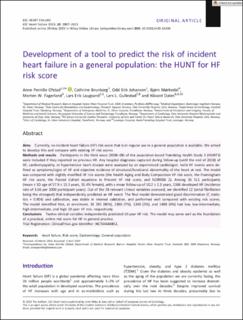| dc.description.abstract | Aims
Currently, no incident heart failure (HF) risk score that is in regular use in a general population is available. We aimed to develop this and compare with existing HF risk scores.
Methods and results
Participants in the third wave (2006–08) of the population-based Trøndelag Health Study 3 (HUNT3) were included if they reported no previous HF. Any hospital diagnoses captured during follow-up (until the end of 2018) of HF, cardiomyopathy, or hypertensive heart disease were assessed by an experienced cardiologist. Valid HF events were defined as symptoms/signs of HF and objective evidence of structural/functional abnormality of the heart at rest. The model was compared with slightly modified HF risk scores (the Health Aging and Body Composition HF risk score, the Framingham HF risk score, the Pooled Cohort equations to Prevent HF risk score, and NORRISK 2). Among 36 511 participants (mean ± SD age of 57.9 ± 13.3 years, 55.4% female), with a mean follow-up of 10.2 ± 1.3 years, 1366 developed HF (incidence rate of 3.66 per 1000 participant years). Out of the 38 relevant clinical variables assessed, we identified 12 (atrial fibrillation being the strongest) that independently predicted an HF event. The final model demonstrated good discrimination (C statistics = 0.904) and calibration, was stable in internal validation, and performed well compared with existing risk scores. The model identified that, at enrolment, 31 391 (86%), 2386 (7%), 1246 (3%), and 1488 (4%) had low, low-intermediate, high-intermediate, and high 10-year HF risk, respectively.
Conclusions
Twelve clinical variables independently predicted 10-year HF risk. The model may serve well as the foundation of a practical, online risk score for HF in general practice. | en_US |

